Mercury Chalcogenide Colloidal Quantum Dots for Infrared Photodetectors
Abstract
:1. Introduction
2. Research on HgTe CQDs
2.1. Synthesis of HgTe CQDs
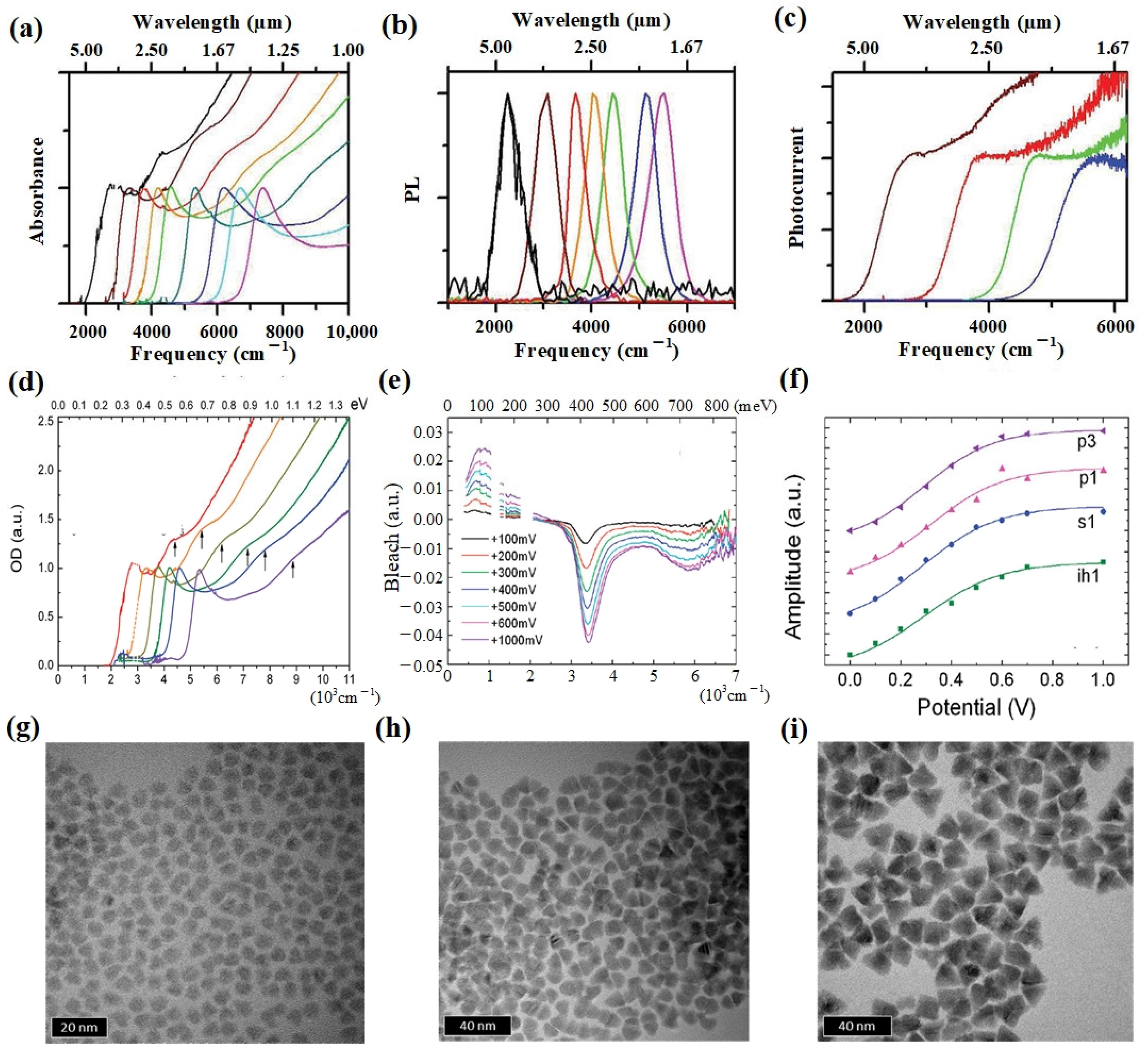
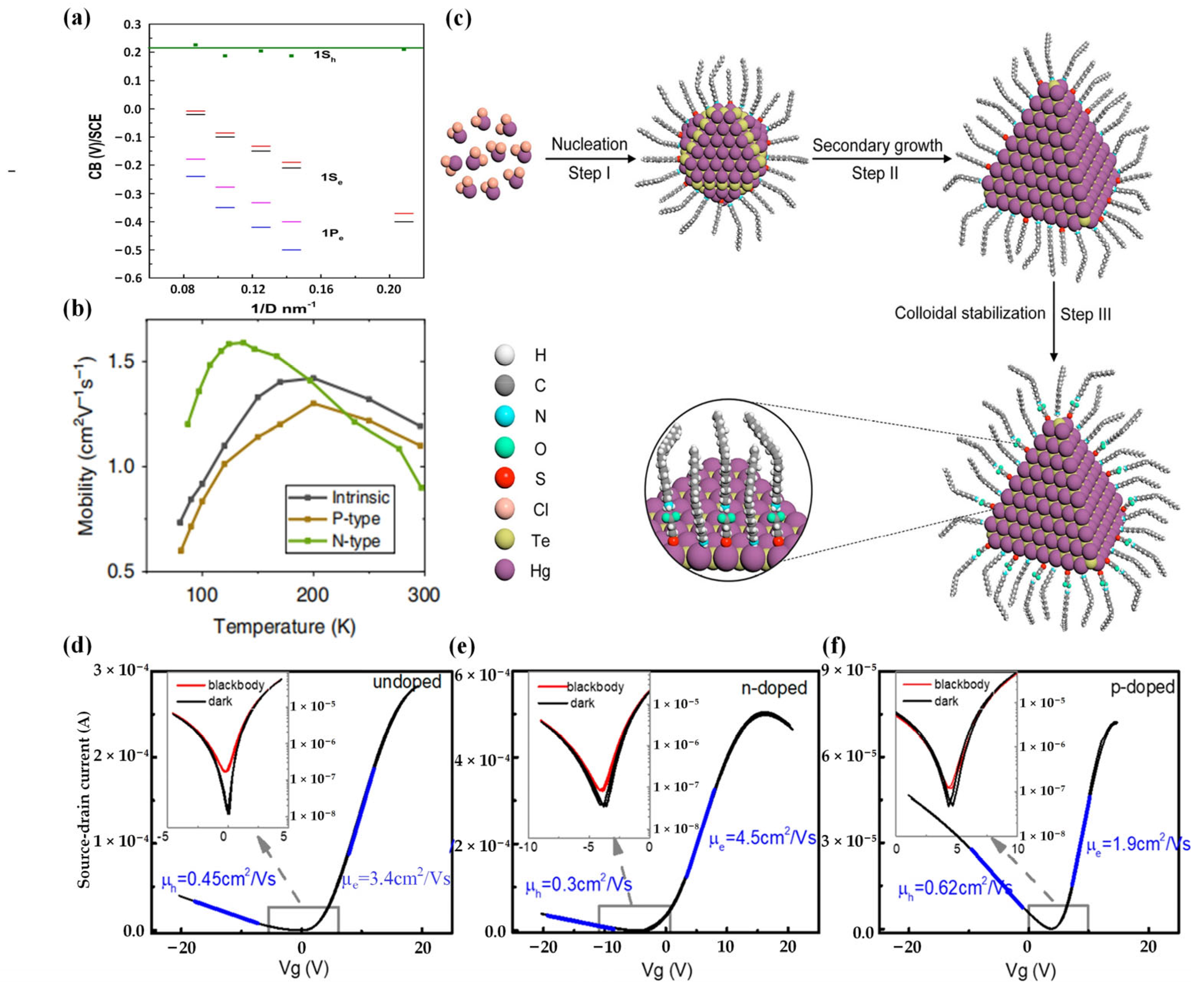
2.2. HgTe CQD Photodetectors
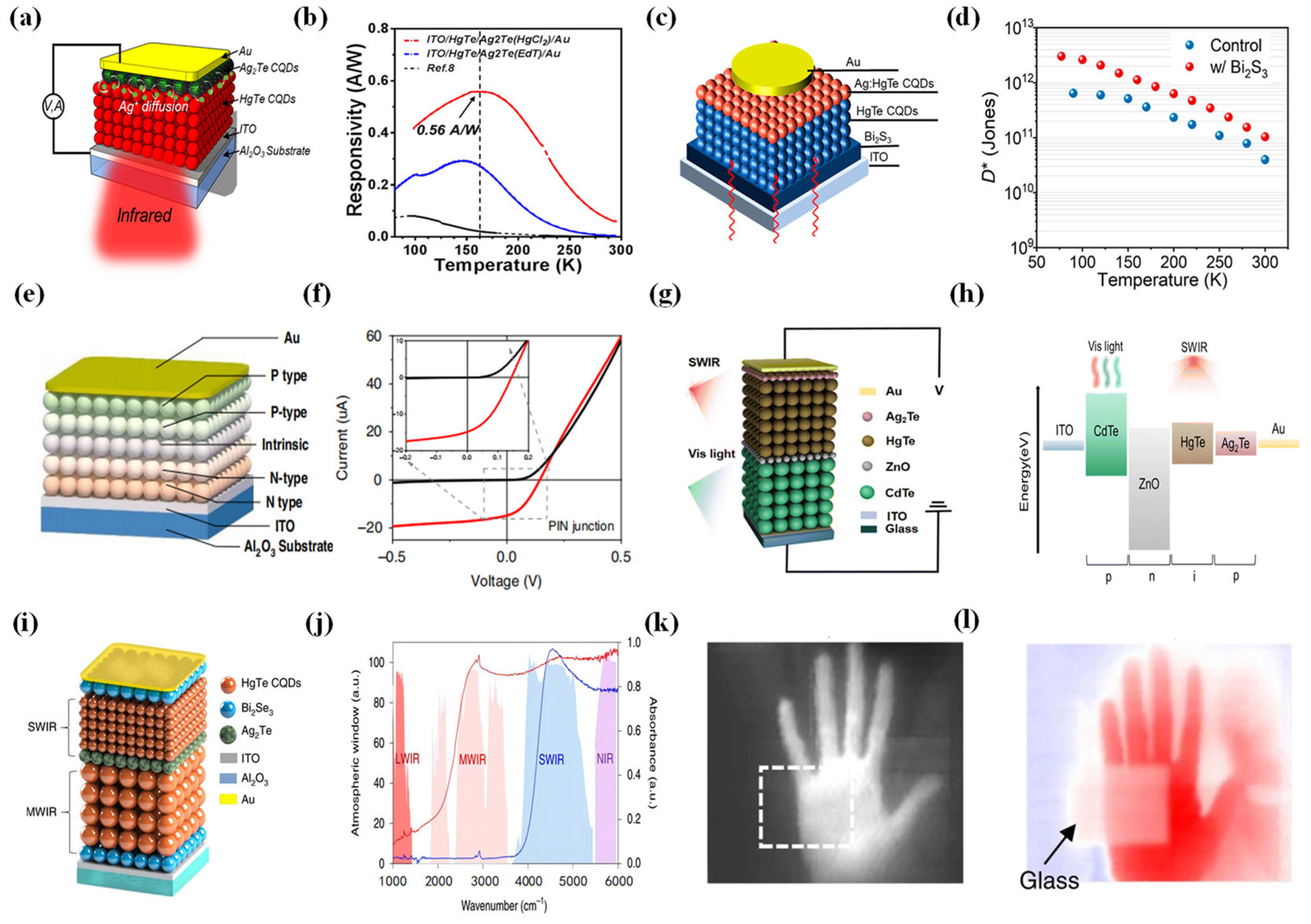
3. Research on HgSe CQDs
3.1. Synthesis of HgSe CQDs
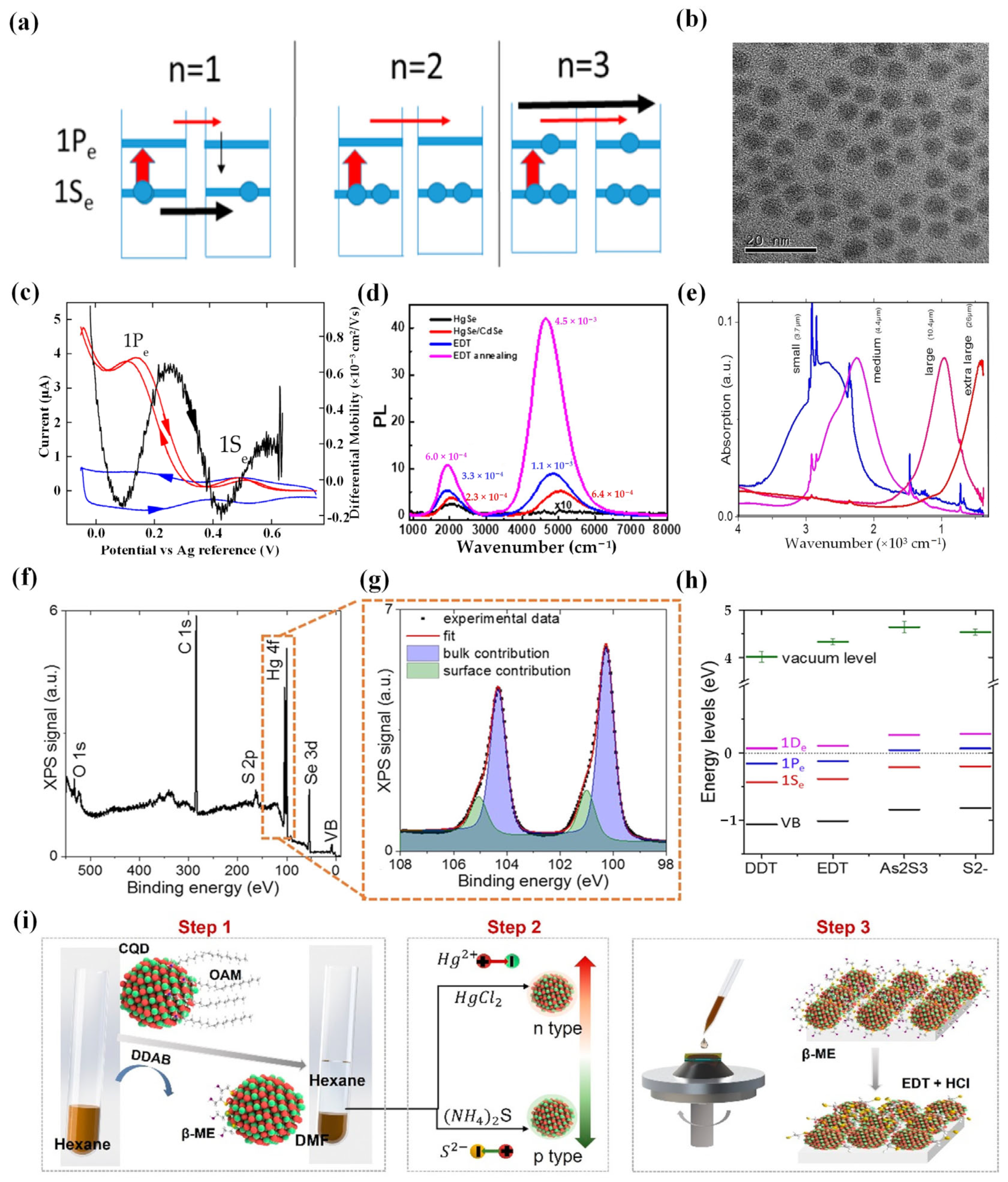
3.2. HgSe CQD Photodetectors
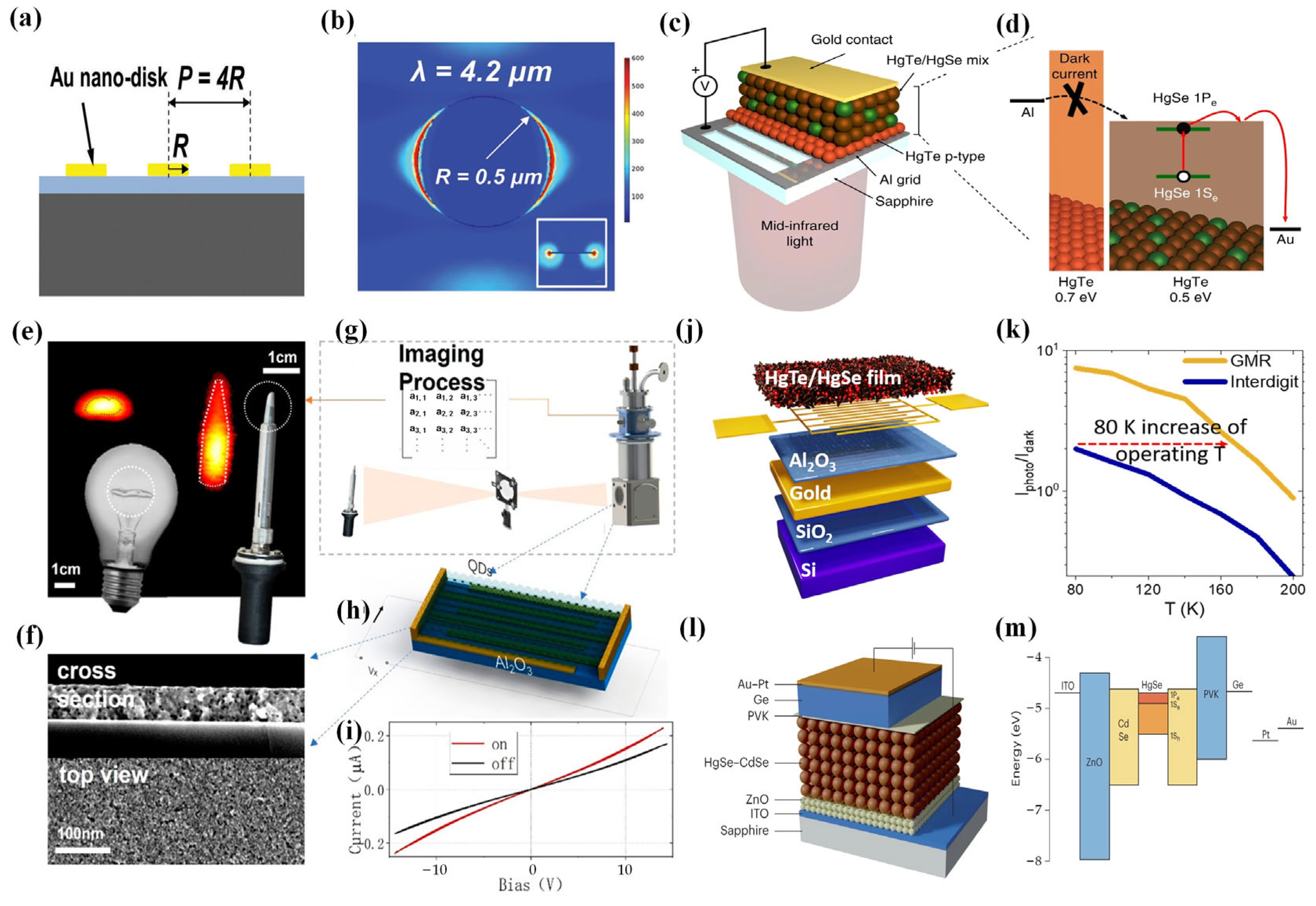
4. HgS-CQD-Based Photodetectors
5. Conclusions
- Material Stability: Mercury sulfide colloidal quantum dots may undergo degradation or deterioration when exposed to prolonged use or high-temperature environments, limiting their widespread applications. Surface modification of quantum dots with organic or inorganic ligands is essential to enhance their stability and improve their dispersion in solutions. This is crucial for the preparation of long-term stable and reliable infrared detectors.
- Limited Photodetection Range: Mercury sulfide quantum dots are primarily used in the near-infrared, short-wave infrared, and mid-infrared spectral range, with fewer applications in the long-wave infrared range. Expanding their photodetection range is necessary to achieve broader spectral detection capabilities.
- Operating Temperature: Theoretically, the quantum-mechanical nature of CQDs implies higher operating temperatures for IR photodetectors, since thermal carrier generation would be significantly reduced compared with the quantum well due to the energy quantization in all three dimensions. Still, cooling is necessary in most CQD photodetectors. Further theoretical and experimental research is needed.
6. Outlook
Author Contributions
Funding
Institutional Review Board Statement
Informed Consent Statement
Data Availability Statement
Conflicts of Interest
References
- Rogalski, A. Toward third generation HgCdTe infrared detectors. J. Alloys Compd. 2004, 371, 53–57. [Google Scholar] [CrossRef]
- Rogalski, A.; Antoszewski, J.; Faraone, L. Third-generation infrared photodetector arrays. J. Appl. Phys. 2009, 105, 091101. [Google Scholar] [CrossRef]
- Schmitt, J.; Flemming, H.-C. FTIR-spectroscopy in microbial and material analysis. Int. Biodeterior. Biodegrad. 1998, 41, 1–11. [Google Scholar] [CrossRef]
- Claire, G.; Federico, C.; Deborah, L.S.; Alfred, Y.C. Recent progress in quantum cascade lasers and applications. Rep. Prog. Phys. 2001, 64, 1533. [Google Scholar]
- Lohse, S.E.; Murphy, C.J. Applications of Colloidal Inorganic Nanoparticles: From Medicine to Energy. J. Am. Chem. Soc. 2012, 134, 15607–15620. [Google Scholar] [CrossRef] [PubMed]
- Yadav, P.V.K.; Ajitha, B.; Kumar Reddy, Y.A.; Sreedhar, A. Recent advances in development of nanostructured photodetectors from ultraviolet to infrared region: A review. Chemosphere 2021, 279, 130473. [Google Scholar] [CrossRef]
- Li, Z.; He, Z.; Xi, C.; Zhang, F.; Huang, L.; Yu, Y.; Tan, H.H.; Jagadish, C.; Fu, L. Review on III–V Semiconductor Nanowire Array Infrared Photodetectors. Adv. Mater. Technol. 2023, 8, 2202126. [Google Scholar] [CrossRef]
- Xia, Y.; Geng, C.; Bi, X.; Li, M.; Zhu, Y.; Yao, Z.; Wan, X.; Li, G.; Chen, Y. Biomimetic Flexible High-Sensitivity Near-Infrared II Organic Photodetector for Photon Detection and Imaging. Adv. Opt. Mater. 2023, 2301518. [Google Scholar] [CrossRef]
- Li, C.; Wang, H.; Wang, F.; Li, T.; Xu, M.; Wang, H.; Wang, Z.; Zhan, X.; Hu, W.; Shen, L. Ultrafast and broadband photodetectors based on a perovskite/organic bulk heterojunction for large-dynamic-range imaging. Light Sci. Appl. 2020, 9, 31. [Google Scholar] [CrossRef]
- Zhang, C.; Luo, Y.; Maier, S.A.; Li, X. Recent Progress and Future Opportunities for Hot Carrier Photodetectors: From Ultraviolet to Infrared Bands. Laser Photonics Rev. 2022, 16, 2100714. [Google Scholar] [CrossRef]
- Lu, Y.; Warner, J.H. Synthesis and Applications of Wide Bandgap 2D Layered Semiconductors Reaching the Green and Blue Wavelengths. ACS Appl. Electron. Mater. 2020, 2, 1777–1814. [Google Scholar] [CrossRef]
- Hu, W.D.; Chen, X.S.; Ye, Z.H.; Lu, W. A hybrid surface passivation on HgCdTe long wave infrared detector with in-situ CdTe deposition and high-density hydrogen plasma modification. Appl. Phys. Lett. 2011, 99, 091101. [Google Scholar] [CrossRef]
- Tan, H.; Fan, C.; Ma, L.; Zhang, X.; Fan, P.; Yang, Y.; Hu, W.; Zhou, H.; Zhuang, X.; Zhu, X.; et al. Single-Crystalline InGaAs Nanowires for Room-Temperature High-Performance Near-Infrared Photodetectors. Nano-Micro Lett. 2016, 8, 29–35. [Google Scholar] [CrossRef] [PubMed]
- Shen, L.; Qian, H.; Yang, Y.; Ma, Y.; Deng, J.; Zhang, Y. Photoresponse Improvement of InGaAs Nanowire Near-Infrared Photodetectors with Self-Assembled Monolayers. J. Phys. Chem. C 2023, 127, 11328–11337. [Google Scholar] [CrossRef]
- Han, I.S.; Kim, J.S.; Shin, J.C.; Kim, J.O.; Noh, S.K.; Lee, S.J.; Krishna, S. Photoluminescence study of InAs/InGaAs sub-monolayer quantum dot infrared photodetectors with various numbers of multiple stack layers. J. Lumin. 2019, 207, 512–519. [Google Scholar] [CrossRef]
- Zhang, H.; Wang, W.; Yip, S.; Li, D.; Li, F.; Lan, C.; Wang, F.; Liu, C.; Ho, J.C. Enhanced performance of near-infrared photodetectors based on InGaAs nanowires enabled by a two-step growth method. J. Mater. Chem. C 2020, 8, 17025–17033. [Google Scholar] [CrossRef]
- Rogalski, A.; Martyniuk, P.; Kopytko, M. Type-II superlattice photodetectors versus HgCdTe photodiodes. Prog. Quantum Electron. 2019, 68, 100228. [Google Scholar] [CrossRef]
- Wang, X.; Wang, M.; Liao, Y.; Zhang, H.; Zhang, B.; Wen, T.; Yi, J.; Qiao, L. Molecular-beam epitaxy-grown HgCdTe infrared detector: Material physics, structure design, and device fabrication. Sci. China Phys. Mech. Astron. 2023, 66, 237302. [Google Scholar] [CrossRef]
- Batty, K.; Steele, I.; Copperwheat, C. Laboratory and On-sky Testing of an InGaAs Detector for Infrared Imaging. Publ. Astron. Soc. Pac. 2022, 134, 65001. [Google Scholar] [CrossRef]
- Chen, J.; Chen, J.; Li, X.; He, J.; Yang, L.; Wang, J.; Yu, F.; Zhao, Z.; Shen, C.; Guo, H.; et al. High-performance HgCdTe avalanche photodetector enabled with suppression of band-to-band tunneling effect in mid-wavelength infrared. npj Quantum Mater. 2021, 6, 103. [Google Scholar] [CrossRef]
- Rothman, J. Physics and Limitations of HgCdTe APDs: A Review. J. Electron. Mater. 2018, 47, 5657–5665. [Google Scholar] [CrossRef]
- Madejczyk, P.; Manyk, T.; Rutkowski, J. Research on Electro-Optical Characteristics of Infrared Detectors with HgCdTe Operating at Room Temperature. Sensors 2023, 23, 1088. [Google Scholar] [CrossRef]
- Ciura, Ł.; Kopytko, M.; Martyniuk, P. Low-frequency noise limitations of InAsSb-, and HgCdTe-based infrared detectors. Sens. Actuators A Phys. 2020, 305, 111908. [Google Scholar] [CrossRef]
- Cao, F.; Liu, L.; Li, L. Short-wave infrared photodetector. Mater. Today 2023, 62, 327–349. [Google Scholar] [CrossRef]
- Choi, K.K. Detection wavelength of quantum-well infrared photodetectors. J. Appl. Phys. 1993, 73, 5230–5236. [Google Scholar] [CrossRef]
- Billaha, M.A.; Das, M.K. Performance analysis of AlGaAs/GaAs/InGaAs-based asymmetric long-wavelength QWIP. Appl. Phys. A 2019, 125, 457. [Google Scholar] [CrossRef]
- Durmaz, H.; Sookchoo, P.; Cui, X.; Jacobson, R.B.; Savage, D.E.; Lagally, M.G.; Paiella, R. SiGe Nanomembrane Quantum-Well Infrared Photodetectors. ACS Photonics 2016, 3, 1978–1985. [Google Scholar] [CrossRef]
- Liu, L.; Chen, Y.; Huang, Z.; Du, W.; Zhan, P.; Wang, Z. Highly efficient metallic optical incouplers for quantum well infrared photodetectors. Sci. Rep. 2016, 6, 30414. [Google Scholar] [CrossRef]
- Mukherjee, R.; Konar, S. Electromagnetically induced transparency based quantum well infrared photodetectors. J. Lumin. 2022, 251, 119176. [Google Scholar] [CrossRef]
- Wu, H.; Jiang, Y.; Li, J.; Ma, X.; Song, J.; Yu, H.; Fu, D.; Xu, Y.; Zhu, H.; Song, G. Performance analysis of an N-structure type-II superlattice photodetector for long wavelength infrared applications. J. Alloys Compd. 2016, 684, 663–668. [Google Scholar] [CrossRef]
- Ting, D.Z.; Soibel, A.; Gunapala, S.D. Hole effective masses and subband splitting in type-II superlattice infrared detectors. Appl. Phys. Lett. 2016, 108, 183504. [Google Scholar] [CrossRef]
- Rogalski, A.; Martyniuk, P.; Kopytko, M. InAs/GaSb type-II superlattice infrared detectors: Future prospect. Appl. Phys. Rev. 2017, 4, 031304. [Google Scholar] [CrossRef]
- Ting, D.Z.; Rafol, S.B.; Khoshakhlagh, A.; Soibel, A.; Keo, S.A.; Fisher, A.M.; Pepper, B.J.; Hill, C.J.; Gunapala, S.D. InAs/InAsSb Type-II Strained-Layer Superlattice Infrared Photodetectors. Micromachines 2020, 11, 958. [Google Scholar] [CrossRef]
- Ribet-Mohamed, I.; Nghiem, J.; Caes, M.; Guénin, M.; Höglund, L.; Costard, E.; Rodriguez, J.B.; Christol, P. Temporal stability and correctability of a MWIR T2SL focal plane array. Infrared Phys. Technol. 2019, 96, 145–150. [Google Scholar] [CrossRef]
- Gerislioglu, B.; Ahmadivand, A.; Adam, J. Infrared plasmonic photodetectors: The emergence of high photon yield toroidal metadevices. Mater. Today Chem. 2019, 14, 100206. [Google Scholar] [CrossRef]
- Ye, X.; Du, Y.; Wang, M.; Liu, B.; Liu, J.; Jafri, S.H.M.; Liu, W.; Papadakis, R.; Zheng, X.; Li, H. Advances in the Field of Two-Dimensional Crystal-Based Photodetectors. Nanomaterials 2023, 13, 1379. [Google Scholar] [CrossRef]
- Amani, M.; Tan, C.; Zhang, G.; Zhao, C.; Bullock, J.; Song, X.; Kim, H.; Shrestha, V.R.; Gao, Y.; Crozier, K.B.; et al. Solution-Synthesized High-Mobility Tellurium Nanoflakes for Short-Wave Infrared Photodetectors. ACS Nano 2018, 12, 7253–7263. [Google Scholar] [CrossRef]
- Peng, M.; Xie, R.; Wang, Z.; Wang, P.; Wang, F.; Ge, H.; Wang, Y.; Zhong, F.; Wu, P.; Ye, J.; et al. Blackbody-sensitive room-temperature infrared photodetectors based on low-dimensional tellurium grown by chemical vapor deposition. Sci. Adv. 2021, 7, eabf7358. [Google Scholar] [CrossRef]
- Yan, Y.; Xia, K.; Gan, W.; Yang, K.; Li, G.; Tang, X.; Li, L.; Zhang, C.; Fei, G.T.; Li, H. A tellurium short-wave infrared photodetector with fast response and high specific detectivity. Nanoscale 2022, 14, 13187–13191. [Google Scholar] [CrossRef] [PubMed]
- Wang, S.; Ashokan, A.; Balendhran, S.; Yan, W.; Johnson, B.C.; Peruzzo, A.; Crozier, K.B.; Mulvaney, P.; Bullock, J. Room Temperature Bias-Selectable, Dual-Band Infrared Detectors Based on Lead Sulfide Colloidal Quantum Dots and Black Phosphorus. ACS Nano 2023, 17, 11771–11782. [Google Scholar] [CrossRef]
- Xu, K.; Xiao, X.; Zhou, W.; Jiang, X.; Wei, Q.; Chen, H.; Deng, Z.; Huang, J.; Chen, B.; Ning, Z. Inverted Si:PbS Colloidal Quantum Dot Heterojunction-Based Infrared Photodetector. ACS Appl. Mater. Interfaces 2020, 12, 15414–15421. [Google Scholar] [CrossRef] [PubMed]
- Nakotte, T.; Munyan, S.G.; Murphy, J.W.; Hawks, S.A.; Kang, S.; Han, J.; Hiszpanski, A.M. Colloidal quantum dot based infrared detectors: Extending to the mid-infrared and moving from the lab to the field. J. Mater. Chem. C 2022, 10, 790–804. [Google Scholar] [CrossRef]
- Imran, M.; Choi, D.; Parmar, D.H.; Rehl, B.; Zhang, Y.; Atan, O.; Kim, G.; Xia, P.; Pina, J.M.; Li, M.; et al. Halide-Driven Synthetic Control of InSb Colloidal Quantum Dots Enables Short-Wave Infrared Photodetectors. Adv. Mater. 2023, 35, 2306147. [Google Scholar]
- Ouyang, J.; Graddage, N.; Lu, J.; Zhong, Y.; Chu, T.-Y.; Zhang, Y.; Wu, X.; Kodra, O.; Li, Z.; Tao, Y.; et al. Ag2Te Colloidal Quantum Dots for Near-Infrared-II Photodetectors. ACS Appl. Nano Mater. 2021, 4, 13587–13601. [Google Scholar] [CrossRef]
- Chen, W.; Tang, H.; Chen, Y.; Heger, J.E.; Li, N.; Kreuzer, L.P.; Xie, Y.; Li, D.; Anthony, C.; Pikramenou, Z.; et al. Spray-deposited PbS colloidal quantum dot solid for near-infrared photodetectors. Nano Energy 2020, 78, 105254. [Google Scholar] [CrossRef]
- Zhu, T.; Yang, Y.; Zheng, L.; Liu, L.; Becker, M.L.; Gong, X. Solution-Processed Flexible Broadband Photodetectors with Solution-Processed Transparent Polymeric Electrode. Adv. Funct. Mater. 2020, 30, 1909487. [Google Scholar] [CrossRef]
- Xu, Q.; Meng, L.; Sinha, K.; Chowdhury, F.I.; Hu, J.; Wang, X. Ultrafast Colloidal Quantum Dot Infrared Photodiode. ACS Photonics 2020, 7, 1297–1303. [Google Scholar] [CrossRef]
- Huang, J.; Guo, D.; Chen, W.; Deng, Z.; Bai, Y.; Wu, T.; Chen, Y.; Liu, H.; Wu, J.; Chen, B. Sub-monolayer quantum dot quantum cascade mid-infrared photodetector. Appl. Phys. Lett. 2017, 111, 251104. [Google Scholar] [CrossRef]
- Zhang, Y.; Tong, X.; Channa, A.I.; Wang, R.; Zhou, N.; Li, X.; Zhao, H.; Huang, Y.; Wang, Z.M. Effective surface passivation of environment-friendly colloidal quantum dots for highly efficient near-infrared photodetectors. J. Mater. Chem. C 2022, 10, 7018–7023. [Google Scholar] [CrossRef]
- Gong, W.; Wang, P.; Deng, W.; Zhang, X.; An, B.; Li, J.; Sun, Z.; Dai, D.; Liu, Z.; Li, J.; et al. Limiting Factors of Detectivity in Near-Infrared Colloidal Quantum Dot Photodetectors. ACS Appl. Mater. Interfaces 2022, 14, 25812–25823. [Google Scholar] [CrossRef]
- Ming, S.-K.; Taylor, R.A.; McNaughter, P.D.; Lewis, D.J.; O’Brien, P. Tunable structural and optical properties of AgxCuyInS2 colloidal quantum dots. New J. Chem. 2022, 46, 18899–18910. [Google Scholar] [CrossRef]
- Geiregat, P.; Van Thourhout, D.; Hens, Z. A bright future for colloidal quantum dot lasers. NPG Asia Mater. 2019, 11, 41. [Google Scholar] [CrossRef]
- Wang, X.; Koleilat, G.I.; Tang, J.; Liu, H.; Kramer, I.J.; Debnath, R.; Brzozowski, L.; Barkhouse, D.A.R.; Levina, L.; Hoogland, S.; et al. Tandem colloidal quantum dot solar cells employing a graded recombination layer. Nat. Photonics 2011, 5, 480–484. [Google Scholar] [CrossRef]
- Goossens, V.M.; Sukharevska, N.V.; Dirin, D.N.; Kovalenko, M.V.; Loi, M.A. Scalable fabrication of efficient p-n junction lead sulfide quantum dot solar cells. Cell Rep. Phys. Sci. 2021, 2, 100655. [Google Scholar] [CrossRef]
- Speirs, M.J.; Dirin, D.N.; Abdu-Aguye, M.; Balazs, D.M.; Kovalenko, M.V.; Loi, M.A. Temperature dependent behaviour of lead sulfide quantum dot solar cells and films. Energy Environ. Sci. 2016, 9, 2916–2924. [Google Scholar] [CrossRef]
- Bao, J.; Bawendi, M.G. A colloidal quantum dot spectrometer. Nature 2015, 523, 67–70. [Google Scholar] [CrossRef] [PubMed]
- Hasan, M.M.; Moyen, E.; Saha, J.K.; Islam, M.M.; Ali, A.; Jang, J. Solution processed high performance perovskite quantum dots/ZnO phototransistors. Nano Res. 2022, 15, 3660–3666. [Google Scholar] [CrossRef]
- Wang, Y.; Yin, L.; Huang, S.; Xiao, R.; Zhang, Y.; Li, D.; Pi, X.; Yang, D. Silicon-Nanomembrane-Based Broadband Synaptic Phototransistors for Neuromorphic Vision. Nano Lett. 2023, 23, 8460–8467. [Google Scholar] [CrossRef]
- Li, W.; Zhang, P.; Li, H.; Sheng, X.; Li, Y.; Xu, X.; Yi, M.; Shi, N.; Shi, W.; Xie, L.; et al. A tricolour photodetecting memory device based on lead sulfide colloidal quantum dots floating gate. Org. Electron. 2019, 75, 105111. [Google Scholar] [CrossRef]
- Kim, T.J.; Lee, S.-h.; Lee, E.; Seo, C.; Kim, J.; Joo, J. Far-Red Interlayer Excitons of Perovskite/Quantum-Dot Heterostructures. Adv. Sci. 2023, 10, 2207653. [Google Scholar] [CrossRef]
- Park, Y.-S.; Roh, J.; Diroll, B.T.; Schaller, R.D.; Klimov, V.I. Colloidal quantum dot lasers. Nat. Rev. Mater. 2021, 6, 382–401. [Google Scholar] [CrossRef]
- Yun, L.; Zhang, H.; Cui, H.; Ding, C.; Ding, Y.; Yu, K.; Wei, W. Lead Sulfide Quantum Dots Mode Locked, Wavelength-Tunable Soliton Fiber Laser. IEEE Photonics Technol. Lett. 2021, 33, 119–122. [Google Scholar] [CrossRef]
- Yun, L.; Ding, C.; Ding, Y.; Han, D.; Zhang, J.; Cui, H.; Wang, Z.; Yu, K. High-Power Mode-Locked Fiber Laser Using Lead Sulfide Quantum Dots Saturable Absorber. J. Light. Technol. 2022, 40, 7901–7906. [Google Scholar] [CrossRef]
- Shen, X.; Peterson, J.C.; Guyot-Sionnest, P. Mid-infrared HgTe Colloidal Quantum Dot LEDs. ACS Nano 2022, 16, 7301–7308. [Google Scholar] [CrossRef] [PubMed]
- Yin, S.; Ho, C.H.Y.; Ding, S.; Fu, X.; Zhu, L.; Gullett, J.; Dong, C.; So, F. Enhanced Surface Passivation of Lead Sulfide Quantum Dots for Short-Wavelength Photodetectors. Chem. Mater. 2022, 34, 5433–5442. [Google Scholar] [CrossRef]
- Dong, C.; Liu, S.; Barange, N.; Lee, J.; Pardue, T.; Yi, X.; Yin, S.; So, F. Long-Wavelength Lead Sulfide Quantum Dots Sensing up to 2600 nm for Short-Wavelength Infrared Photodetectors. ACS Appl. Mater. Interfaces 2019, 11, 44451–44457. [Google Scholar] [CrossRef]
- Liu, M.; Yazdani, N.; Yarema, M.; Jansen, M.; Wood, V.; Sargent, E.H. Colloidal quantum dot electronics. Nat. Electron. 2021, 4, 548–558. [Google Scholar] [CrossRef]
- Guo, R.; Zhang, M.; Ding, J.; Liu, A.; Huang, F.; Sheng, M. Advances in colloidal quantum dot-based photodetectors. J. Mater. Chem. C 2022, 10, 7404–7422. [Google Scholar] [CrossRef]
- Qin, T.; Mu, G.; Zhao, P.; Tan, Y.; Liu, Y.; Zhang, S.; Luo, Y.; Hao, Q.; Chen, M.; Tang, X. Mercury telluride colloidal quantum-dot focal plane array with planar p-n junctions enabled by in situ electric field–activated doping. Sci. Adv. 2023, 9, eadg7827. [Google Scholar] [CrossRef]
- Gréboval, C.; Chu, A.; Goubet, N.; Livache, C.; Ithurria, S.; Lhuillier, E. Mercury Chalcogenide Quantum Dots: Material Perspective for Device Integration. Chem. Rev. 2021, 121, 3627–3700. [Google Scholar] [CrossRef]
- Tian, Y.; Luo, H.; Chen, M.; Li, C.; Kershaw, S.V.; Zhang, R.; Rogach, A.L. Mercury chalcogenide colloidal quantum dots for infrared photodetection: From synthesis to device applications. Nanoscale 2023, 15, 6476–6504. [Google Scholar] [CrossRef] [PubMed]
- Shen, L.; Pun, E.Y.; Ho, J.C. Recent developments in III–V semiconducting nanowires for high-performance photodetectors. Mater. Chem. Front. 2017, 1, 630–645. [Google Scholar] [CrossRef]
- Sergeeva, K.A.; Fan, K.; Sergeev, A.A.; Hu, S.; Liu, H.; Chan, C.C.; Kershaw, S.V.; Wong, K.S.; Rogach, A.L. Ultrafast Charge Carrier Dynamics and Transport Characteristics in HgTe Quantum Dots. J. Phys. Chem. C 2022, 126, 19229–19239. [Google Scholar] [CrossRef]
- Zhang, H.; Peterson, J.C.; Guyot-Sionnest, P. Intraband Transition of HgTe Nanocrystals for Long-Wave Infrared Detection at 12 μm. ACS Nano 2023, 17, 7530–7538. [Google Scholar] [CrossRef] [PubMed]
- Harrison, M.T.; Kershaw, S.V.; Burt, M.G.; Rogach, A.; Eychmüller, A.; Weller, H. Investigation of factors affecting the photoluminescence of colloidally-prepared HgTe nanocrystals. J. Mater. Chem. 1999, 9, 2721–2722. [Google Scholar] [CrossRef]
- Harrison, M.T.; Kershaw, S.V.; Burt, M.G.; Rogach, A.L.; Kornowski, A.; Eychmüller, A.; Weller, H. Colloidal nanocrystals for telecommunications. Complete coverage of the low-loss fiber windows by mercury telluride quantum dot. Pure Appl. Chem. 2000, 72, 295–307. [Google Scholar] [CrossRef]
- Kershaw, S.V.; Burt, M.; Harrison, M.; Rogach, A.; Weller, H.; Eychmüller, A. Colloidal CdTe/HgTe quantum dots with high photoluminescence quantum efficiency at room temperature. Appl. Phys. Lett. 1999, 75, 1694–1696. [Google Scholar] [CrossRef]
- Keuleyan, S.; Lhuillier, E.; Guyot-Sionnest, P. Synthesis of colloidal HgTe quantum dots for narrow mid-IR emission and detection. J. Am. Chem. Soc. 2011, 133, 16422–16424. [Google Scholar] [CrossRef]
- Lhuillier, E.; Keuleyan, S.; Guyot-Sionnest, P. Optical properties of HgTe colloidal quantum dots. Nanotechnology 2012, 23, 175705. [Google Scholar] [CrossRef]
- Keuleyan, S.; Kohler, J.; Guyot-Sionnest, P. Photoluminescence of Mid-Infrared HgTe Colloidal Quantum Dots. J. Phys. Chem. C 2014, 118, 2749–2753. [Google Scholar] [CrossRef]
- Guyot-Sionnest, P. Electrical Transport in Colloidal Quantum Dot Films. J. Phys. Chem. Lett. 2012, 3, 1169–1175. [Google Scholar] [CrossRef] [PubMed]
- Eyink, K.; Lhuillier, E.; Keuleyan, S.; Guyot-Sionnest, P.; Szmulowicz, F.; Huffaker, D. Transport properties of mid-infrared colloidal quantum dot films. In Quantum Dots and Nanostructures: Synthesis, Characterization, and Modeling IX; SPIE: Bellingham, WA, USA, 2012. [Google Scholar]
- Keuleyan, S.; Lhuillier, E.; Brajuskovic, V.; Guyot-Sionnest, P. Mid-infrared HgTe colloidal quantum dot photodetectors. Nat. Photonics 2011, 5, 489–493. [Google Scholar] [CrossRef]
- Liu, H.; Keuleyan, S.; Guyot-Sionnest, P. n- and p-Type HgTe Quantum Dot Films. J. Phys. Chem. C 2011, 116, 1344–1349. [Google Scholar] [CrossRef]
- Ba, K.; Wang, J. Advances in solution-processed quantum dots based hybrid structures for infrared photodetector. Mater. Today 2022, 58, 119–134. [Google Scholar] [CrossRef]
- Lhuillier, E.; Keuleyan, S.; Zolotavin, P.; Guyot-Sionnest, P. Mid-infrared HgTe/As2S3 field effect transistors and photodetectors. Adv. Mater. 2013, 25, 137–141. [Google Scholar] [CrossRef]
- Keuleyan, S.E.; Guyot-Sionnest, P.; Delerue, C.; Allan, G. Mercury Telluride Colloidal Quantum Dots: Electronic Structure, Size-Dependent Spectra, and Photocurrent Detection up to 12 μm. ACS Nano 2014, 8, 8676–8682. [Google Scholar] [CrossRef] [PubMed]
- Shen, G.; Chen, M.; Guyot-Sionnest, P. Synthesis of Nonaggregating HgTe Colloidal Quantum Dots and the Emergence of Air-Stable n-Doping. J. Phys. Chem. Lett. 2017, 8, 2224–2228. [Google Scholar] [CrossRef]
- Chen, M.; Lan, X.; Tang, X.; Wang, Y.; Hudson, M.H.; Talapin, D.V.; Guyot-Sionnest, P. High Carrier Mobility in HgTe Quantum Dot Solids Improves Mid-IR Photodetectors. ACS Photonics 2019, 6, 2358–2365. [Google Scholar] [CrossRef]
- Lan, X.; Chen, M.; Hudson, M.H.; Kamysbayev, V.; Wang, Y.; Guyot-Sionnest, P.; Talapin, D.V. Quantum dot solids showing state-resolved band-like transport. Nat. Mater. 2020, 19, 323–329. [Google Scholar] [CrossRef]
- Xue, X.; Chen, M.; Luo, Y.; Qin, T.; Tang, X.; Hao, Q. High-operating-temperature mid-infrared photodetectors via quantum dot gradient homojunction. Light Sci. Appl. 2023, 12, 2. [Google Scholar] [CrossRef]
- Liu, Z.; Wang, P.; Dong, R.; Gong, W.; Li, J.; Dai, D.; Yan, H.; Zhang, Y. Mid-Infrared HgTe Colloidal Quantum Dots In-Situ Passivated by Iodide. Coatings 2022, 12, 1033. [Google Scholar] [CrossRef]
- Yang, J.; Hu, H.; Lv, Y.; Yuan, M.; Wang, B.; He, Z.; Chen, S.; Wang, Y.; Hu, Z.; Yu, M.; et al. Ligand-Engineered HgTe Colloidal Quantum Dot Solids for Infrared Photodetectors. Nano Lett. 2022, 22, 3465–3472. [Google Scholar] [CrossRef] [PubMed]
- Chen, M.; Yu, H.; Kershaw, S.V.; Xu, H.; Gupta, S.; Hetsch, F.; Rogach, A.L.; Zhao, N. Fast, Air-Stable Infrared Photodetectors based on Spray-Deposited Aqueous HgTe Quantum Dots. Adv. Funct. Mater. 2014, 24, 53–59. [Google Scholar] [CrossRef]
- Chen, M.; Lu, H.; Abdelazim, N.M.; Zhu, Y.; Wang, Z.; Ren, W.; Kershaw, S.V.; Rogach, A.L.; Zhao, N. Mercury Telluride Quantum Dot Based Phototransistor Enabling High-Sensitivity Room-Temperature Photodetection at 2000 nm. ACS Nano 2017, 11, 5614–5622. [Google Scholar] [CrossRef] [PubMed]
- Dong, Y.; Chen, M.; Yiu, W.K.; Zhu, Q.; Zhou, G.; Kershaw, S.V.; Ke, N.; Wong, C.P.; Rogach, A.L.; Zhao, N. Solution Processed Hybrid Polymer: HgTe Quantum Dot Phototransistor with High Sensitivity and Fast Infrared Response up to 2400 nm at Room Temperature. Adv. Sci. 2020, 7, 2000068. [Google Scholar] [CrossRef] [PubMed]
- Guyot-Sionnest, P.; Roberts, J.A. Background limited mid-infrared photodetection with photovoltaic HgTe colloidal quantum dots. Appl. Phys. Lett. 2015, 107, 253104. [Google Scholar] [CrossRef]
- Ackerman, M.M.; Tang, X.; Guyot-Sionnest, P. Fast and Sensitive Colloidal Quantum Dot Mid-Wave Infrared Photodetectors. ACS Nano 2018, 12, 7264–7271. [Google Scholar] [CrossRef] [PubMed]
- Yang, J.; Lv, Y.; He, Z.; Wang, B.; Chen, S.; Xiao, F.; Hu, H.; Yu, M.; Liu, H.; Lan, X.; et al. Bi2S3 Electron Transport Layer Incorporation for High-Performance Heterostructure HgTe Colloidal Quantum Dot Infrared Photodetectors. ACS Photonics 2023, 10, 2226–2233. [Google Scholar] [CrossRef]
- Marshall, A.R.; Young, M.R.; Nozik, A.J.; Beard, M.C.; Luther, J.M. Exploration of Metal Chloride Uptake for Improved Performance Characteristics of PbSe Quantum Dot Solar Cells. J. Phys. Chem. Lett. 2015, 6, 2892–2899. [Google Scholar] [CrossRef]
- Kirkwood, N.; Monchen, J.O.V.; Crisp, R.W.; Grimaldi, G.; Bergstein, H.A.C.; du Fosse, I.; van der Stam, W.; Infante, I.; Houtepen, A.J. Finding and Fixing Traps in II-VI and III-V Colloidal Quantum Dots: The Importance of Z-Type Ligand Passivation. J. Am. Chem. Soc. 2018, 140, 15712–15723. [Google Scholar] [CrossRef]
- Ackerman, M.M.; Chen, M.; Guyot-Sionnest, P. HgTe colloidal quantum dot photodiodes for extended short-wave infrared detection. Appl. Phys. Lett. 2020, 116, 083502. [Google Scholar] [CrossRef]
- Tang, X.; Ackerman, M.M.; Chen, M.; Guyot-Sionnest, P. Dual-band infrared imaging using stacked colloidal quantum dot photodiodes. Nat. Photonics 2019, 13, 277–282. [Google Scholar] [CrossRef]
- Zhao, P.; Qin, T.; Mu, G.; Zhang, S.; Luo, Y.; Chen, M.; Tang, X. Band-engineered dual-band visible and short-wave infrared photodetector with metal chalcogenide colloidal quantum dots. J. Mater. Chem. C 2023, 11, 2842–2850. [Google Scholar] [CrossRef]
- Tang, X.; Ackerman, M.M.; Guyot-Sionnest, P. Thermal Imaging with Plasmon Resonance Enhanced HgTe Colloidal Quantum Dot Photovoltaic Devices. ACS Nano 2018, 12, 7362–7370. [Google Scholar] [CrossRef] [PubMed]
- Luo, Y.; Zhang, S.; Tang, X.; Chen, M. Resonant cavity-enhanced colloidal quantum-dot dual-band infrared photodetectors. J. Mater. Chem. C 2022, 10, 8218–8225. [Google Scholar] [CrossRef]
- Tang, X.; Ackerman, M.M.; Shen, G.; Guyot-Sionnest, P. Towards Infrared Electronic Eyes: Flexible Colloidal Quantum Dot Photovoltaic Detectors Enhanced by Resonant Cavity. Small 2019, 15, e1804920. [Google Scholar] [CrossRef]
- Tang, X.; Ackerman, M.M.; Guyot-Sionnest, P. Acquisition of Hyperspectral Data with Colloidal Quantum Dots. Laser Photonics Rev. 2019, 13, 1900165. [Google Scholar] [CrossRef]
- Ciani, A.J.; Pimpinella, R.E.; Grein, C.H.; Guyot-Sionnest, P. Colloidal quantum dots for low-cost MWIR imaging. In Infrared Technology and Applications XLII; SPIE: Bellingham, WA, USA, 2016. [Google Scholar]
- Gréboval, C.; Darson, D.; Parahyba, V.; Alchaar, R.; Abadie, C.; Noguier, V.; Ferré, S.; Izquierdo, E.; Khalili, A.; Prado, Y.; et al. Photoconductive focal plane array based on HgTe quantum dots for fast and cost-effective short-wave infrared imaging. Nanoscale 2022, 14, 9359–9368. [Google Scholar] [CrossRef]
- Alchaar, R.; Khalili, A.; Ledos, N.; Dang, T.H.; Lebreton, M.; Cavallo, M.; Bossavit, E.; Zhang, H.; Prado, Y.; Lafosse, X.; et al. Focal plane array based on HgTe nanocrystals with photovoltaic operation in the short-wave infrared. Appl. Phys. Lett. 2023, 123, 051108. [Google Scholar] [CrossRef]
- Zhang, S.; Bi, C.; Qin, T.; Liu, Y.; Cao, J.; Song, J.; Huo, Y.; Chen, M.; Hao, Q.; Tang, X. Wafer-Scale Fabrication of CMOS-Compatible Trapping-Mode Infrared Imagers with Colloidal Quantum Dots. ACS Photonics 2023, 10, 673–682. [Google Scholar] [CrossRef]
- Izquierdo, E.; Dufour, M.; Chu, A.; Livache, C.; Martinez, B.; Amelot, D.; Patriarche, G.; Lequeux, N.; Lhuillier, E.; Ithurria, S. Coupled HgSe Colloidal Quantum Wells through a Tunable Barrier: A Strategy To Uncouple Optical and Transport Band Gap. Chem. Mater. 2018, 30, 4065–4072. [Google Scholar] [CrossRef]
- Sato, S.A.; Lucchini, M.; Volkov, M.; Schlaepfer, F.; Gallmann, L.; Keller, U.; Rubio, A.; Sato, S.A.; Lucchini, M.; Volkov, M.; et al. Role of intraband transitions in photocarrier generation. Phys. Rev. B 2018, 98, 035202. [Google Scholar] [CrossRef]
- Livache, C.; Goubet, N.; Gréboval, C.; Martinez, B.; Ramade, J.; Qu, J.; Triboulin, A.; Cruguel, H.; Baptiste, B.; Klotz, S.; et al. Effect of Pressure on Interband and Intraband Transition of Mercury Chalcogenide Quantum Dots. J. Phys. Chem. C 2019, 123, 13122–13130. [Google Scholar] [CrossRef]
- Grigel, V.; Sagar, L.K.; De Nolf, K.; Zhao, Q.; Vantomme, A.; De Roo, J.; Infante, I.; Hens, Z. The Surface Chemistry of Colloidal HgSe Nanocrystals, toward Stoichiometric Quantum Dots by Design. Chem. Mater. 2018, 30, 7637–7647. [Google Scholar] [CrossRef]
- Wang, S.; Zhang, X.; Wang, Y.; Guo, T.; Cao, S. Influence of Ink Properties on the Morphology of Long-Wave Infrared HgSe Quantum Dot Films. Nanomaterials 2022, 12, 2180. [Google Scholar] [CrossRef] [PubMed]
- Deng, Z.; Jeong, K.S.; Guyot-Sionnest, P. Colloidal Quantum Dots Intraband Photodetectors. ACS Nano 2014, 8, 11707–11714. [Google Scholar] [CrossRef]
- Hines, M.A.; Guyot-Sionnest, P. Synthesis and Characterization of Strongly Luminescing ZnS-Capped CdSe Nanocrystals. J. Phys. Chem. 1996, 100, 468–471. [Google Scholar] [CrossRef]
- Cao; Banin, U. Growth and Properties of Semiconductor Core/Shell Nanocrystals with InAs Cores. J. Am. Chem. Soc. 2000, 122, 9692–9702. [Google Scholar] [CrossRef]
- Cumberland, S.L.; Hanif, K.M.; Javier, A.; Khitrov, G.A.; Strouse, G.F.; Woessner, S.M.; Yun, C.S. Inorganic Clusters as Single-Source Precursors for Preparation of CdSe, ZnSe, and CdSe/ZnS Nanomaterials. Chem. Mater. 2002, 14, 1576–1584. [Google Scholar] [CrossRef]
- Reiss, P.; Bleuse, J.; Pron, A. Highly Luminescent CdSe/ZnSe Core/Shell Nanocrystals of Low Size Dispersion. Nano Lett. 2002, 2, 781–784. [Google Scholar] [CrossRef]
- Deng, Z.; Guyot-Sionnest, P. Intraband Luminescence from HgSe/CdS Core/Shell Quantum Dots. ACS Nano 2016, 10, 2121–2127. [Google Scholar] [CrossRef] [PubMed]
- Shen, G.; Guyot-Sionnest, P. HgTe/CdTe and HgSe/CdX (X = S, Se, and Te) Core/Shell Mid-Infrared Quantum Dots. Chem. Mater. 2018, 31, 286–293. [Google Scholar] [CrossRef]
- Kamath, A.; Melnychuk, C.; Guyot-Sionnest, P. Toward Bright Mid-Infrared Emitters: Thick-Shell n-Type HgSe/CdS Nanocrystals. J. Am. Chem. Soc. 2021, 143, 19567–19575. [Google Scholar] [CrossRef] [PubMed]
- Shen, X.; Kamath, A.; Guyot-Sionnest, P. Mid-infrared cascade intraband electroluminescence with HgSe–CdSe core–shell colloidal quantum dots. Nat. Photonics 2023, 10, 1–5. [Google Scholar] [CrossRef]
- Martinez, B.; Livache, C.; Notemgnou Mouafo, L.D.; Goubet, N.; Keuleyan, S.; Cruguel, H.; Ithurria, S.; Aubin, H.; Ouerghi, A.; Doudin, B.; et al. HgSe Self-Doped Nanocrystals as a Platform to Investigate the Effects of Vanishing Confinement. ACS Appl. Mater. Interfaces 2017, 9, 36173–36180. [Google Scholar] [CrossRef]
- Martinez, B.; Livache, C.; Meriggio, E.; Xu, X.Z.; Cruguel, H.; Lacaze, E.; Proust, A.; Ithurria, S.; Silly, M.G.; Cabailh, G.; et al. Polyoxometalate as Control Agent for the Doping in HgSe Self-Doped Nanocrystals. J. Phys. Chem. C 2018, 122, 26680–26685. [Google Scholar] [CrossRef]
- Chen, M.; Shen, G.; Guyot-Sionnest, P. State-Resolved Mobility of 1 cm2/(Vs) with HgSe Quantum Dot Films. J. Phys. Chem. Lett. 2020, 11, 2303–2307. [Google Scholar] [CrossRef]
- Chen, M.; Hao, Q.; Luo, Y.; Tang, X. Mid-Infrared Intraband Photodetector via High Carrier Mobility HgSe Colloidal Quantum Dots. ACS Nano 2022, 16, 11027–11035. [Google Scholar] [CrossRef]
- Chen, M.; Shen, G.; Guyot-Sionnest, P. Size Distribution Effects on Mobility and Intraband Gap of HgSe Quantum Dots. J. Phys. Chem. C 2020, 124, 16216–16221. [Google Scholar] [CrossRef]
- Tang, X.; Wu, G.f.; Lai, K.W.C. Plasmon resonance enhanced colloidal HgSe quantum dot filterless narrowband photodetectors for mid-wave infrared. J. Mater. Chem. C 2017, 5, 362–369. [Google Scholar] [CrossRef]
- Sokolova, D.; Dyomkin, D.V.; Katsaba, A.V.; Bocharova, S.I.; Razumov, V.F. Effect of different ligand types on sensitivity of infrared photodetectors based on colloidal HgSe quantum dots. Infrared Phys. Technol. 2022, 123, 104188. [Google Scholar] [CrossRef]
- Lhuillier, E.; Guyot-Sionnest, P. Recent Progresses in Mid Infrared Nanocrystal Optoelectronics. IEEE J. Sel. Top. Quantum Electron. 2017, 23, 1–8. [Google Scholar] [CrossRef]
- Livache, C.; Martinez, B.; Goubet, N.; Greboval, C.; Qu, J.; Chu, A.; Royer, S.; Ithurria, S.; Silly, M.G.; Dubertret, B.; et al. A colloidal quantum dot infrared photodetector and its use for intraband detection. Nat. Commun. 2019, 10, 2125. [Google Scholar] [CrossRef] [PubMed]
- Khalili, A.; Weis, M.; Mizrahi, S.G.; Chu, A.; Dang, T.H.; Abadie, C.; Gréboval, C.; Dabard, C.; Prado, Y.; Xu, X.Z.; et al. Guided-Mode Resonator Coupled with Nanocrystal Intraband Absorption. ACS Photonics 2022, 9, 985–993. [Google Scholar] [CrossRef]
- Jagtap, A.; Livache, C.; Martinez, B.; Qu, J.; Chu, A.; Gréboval, C.; Goubet, N.; Lhuillier, E. Emergence of intraband transitions in colloidal nanocrystals [Invited]. Opt. Mater. Express 2018, 8, 1174–1183. [Google Scholar] [CrossRef]
- Jeong, K.S.; Deng, Z.; Keuleyan, S.; Liu, H.; Guyot-Sionnest, P. Air-Stable n-Doped Colloidal HgS Quantum Dots. J. Phys. Chem. Lett. 2014, 5, 1139–1143. [Google Scholar] [CrossRef]
- Kim, J.; Yoon, B.; Kim, J.; Choi, Y.; Kwon, Y.-W.; Park, S.K.; Jeong, K.S. High electron mobility of β-HgS colloidal quantum dots with doubly occupied quantum states. RSC Adv. 2017, 7, 38166–38170. [Google Scholar] [CrossRef]
- Shen, G.; Guyot-Sionnest, P. HgS and HgS/CdS Colloidal Quantum Dots with Infrared Intraband Transitions and Emergence of a Surface Plasmon. J. Phys. Chem. C 2016, 120, 11744–11753. [Google Scholar] [CrossRef]
- Yoon, B.; Jeong, J.; Jeong, K.S. Higher Quantum State Transitions in Colloidal Quantum Dot with Heavy Electron Doping. J. Phys. Chem. C 2016, 120, 22062–22068. [Google Scholar] [CrossRef]
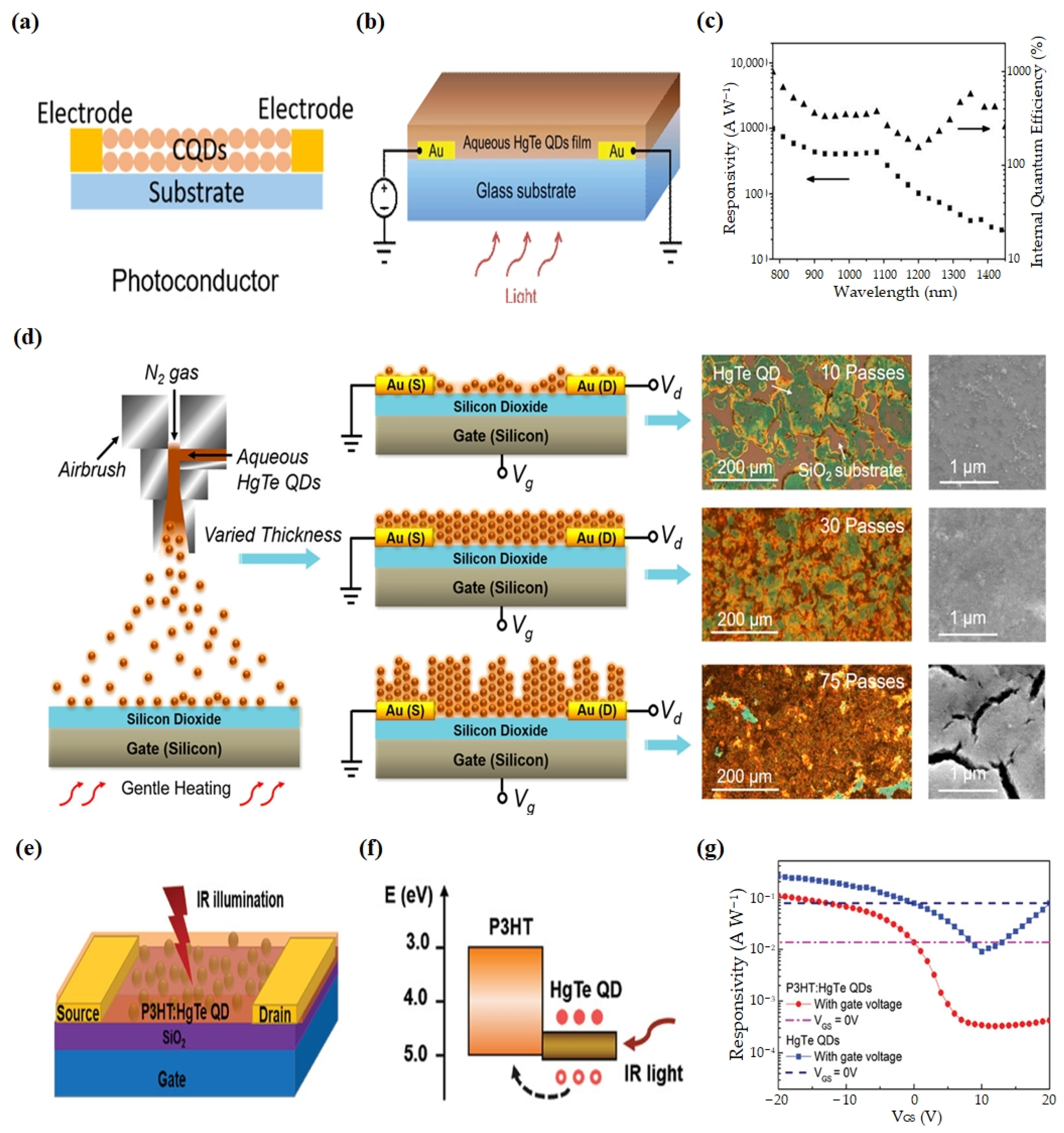
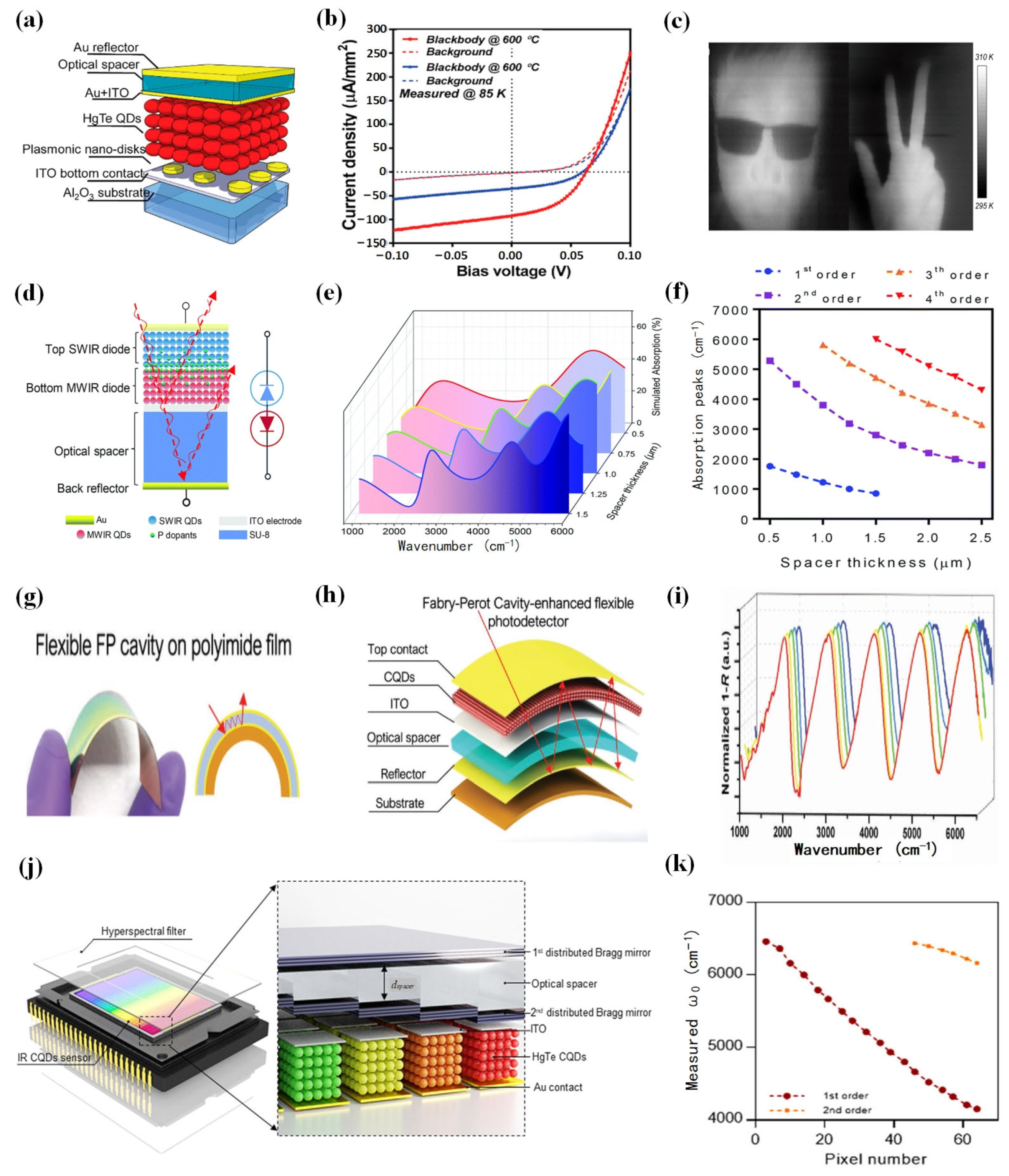
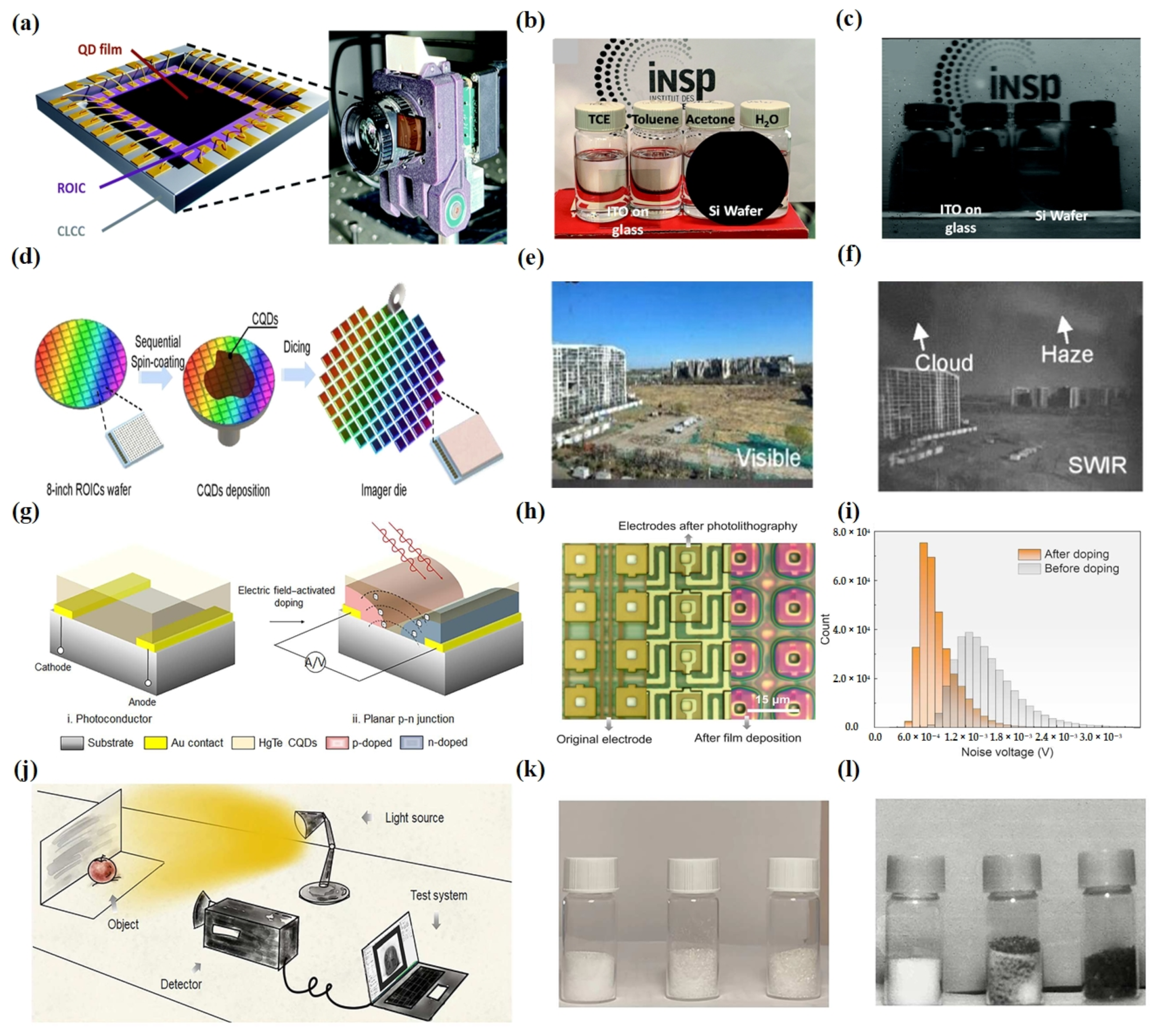
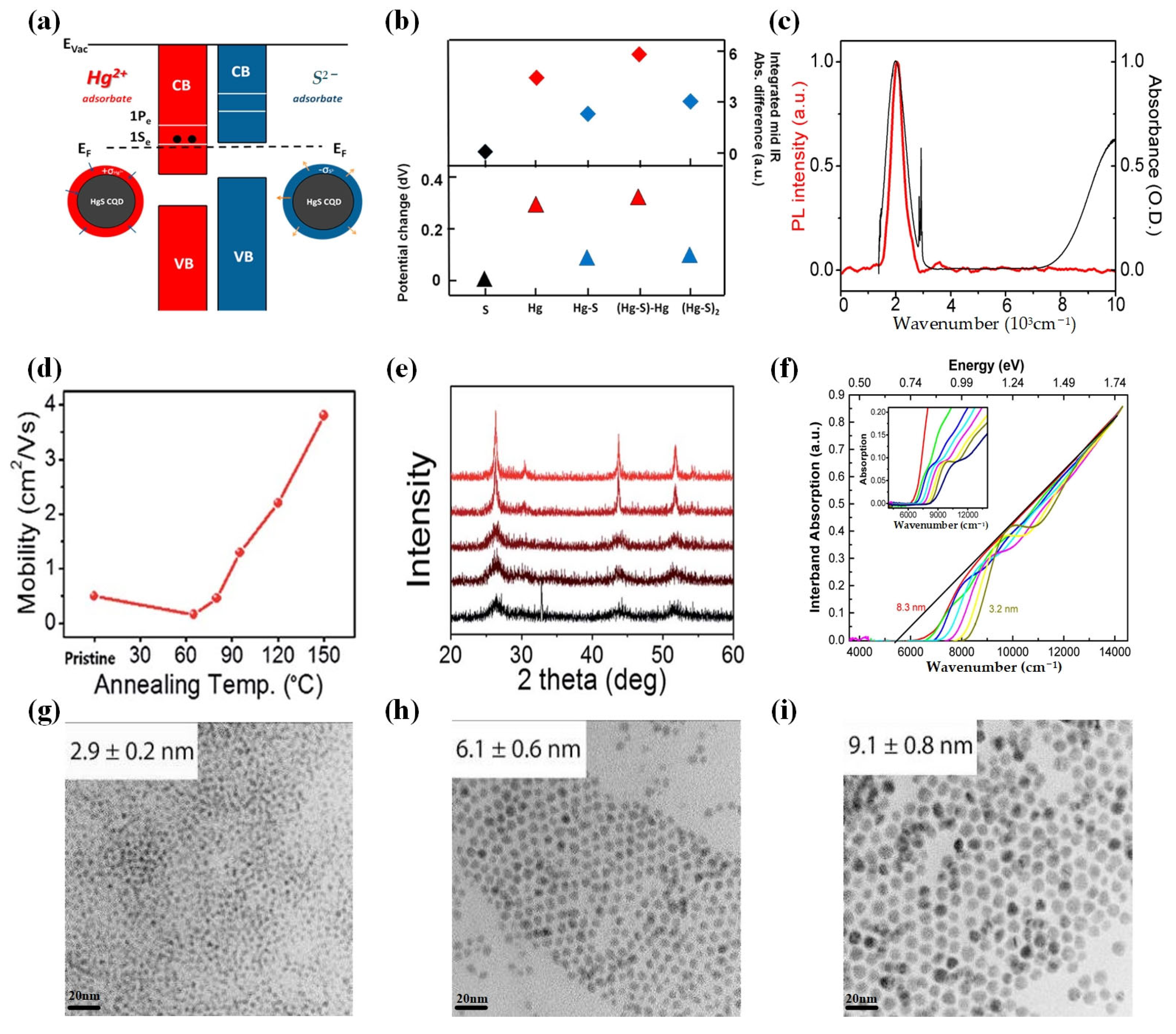

| Year | Photoactive Material | Detection Range (nm) | Detectivity (Jones) | Responsivity (A/W) | Rise Decay Time | Ref. |
|---|---|---|---|---|---|---|
| Photodetectors based on HgTe CQDs | ||||||
| 2011 | HgTe CQDs | 5000 | 2 × 109 | -- | -- | [83] |
| 2013 | HgTe CQDs/As2S3 | 3500 | 3.5 × 1010 | 0.1 | -- | [86] |
| 2014 | HgTe CQDs | 1600 | -- | -- | 2 μs | [94] |
| 2015 | HgTe CQDs | 5250 | 4.2 × 1010 | -- | -- | [97] |
| 2016 | HgTe CQDs | 3600 | 2 × 1010 | -- | -- | [109] |
| 2017 | HgTe CQDs | 2000 | 2 × 1010 | 0.4 | 12.6 μs | [95] |
| 2018 | HgTe CQDs | 4000/4500 | 1 × 1010 @4000 nm 4 × 1010 @4500 nm | 1.62 @4500 nm | -- | [105] |
| 2018 | HgTe CQDs/Ag2Te | 5000 | 3.3 × 1011 | 1.3 | -- | [98] |
| 2019 | HgTe CQDs | 5000 | 5.4 × 1010 | -- | -- | [89] |
| 2019 | HgTe CQDs | 2200 | 7.5 × 1010 | -- | -- | [107] |
| 2019 | HgTe CQDs | 2500/4500 | 1 × 1010 | -- | -- | [103] |
| 2020 | HgTe CQDs | 4000 | 5.4 × 1010 | 0.23 | -- | [90] |
| 2020 | HgTe CQDs/P3HT | 2400 | >1 × 1011 | -- | <1.5 μs | [96] |
| 2022 | HgTe CQDs | 2350/4000 | 2 × 1011 | 1.1 @2350 nm 1.6 @4000 nm | -- | [106] |
| 2023 | HgTe CQDs | 3500/4200 | 7.6 × 109 @3500 nm @300 K 2.7 × 1011 @4200 nm @80 K >1 × 1011 @4200 nm @200 K >1 × 1010 @4200 nm @280 K | 2.7 | -- | [91] |
| 2023 | HgTe CQDs/Bi2S3 | 2200 | 1 × 1011 | -- | 8 μs | [99] |
| 2023 | HgTe CQDs/CdTe CQDs | 700/2100 | 1 × 1011 @700 nm 4.5 × 1011 @2100 nm | 0.5 @700 nm 1.1 @2100 nm | -- | [104] |
| 2023 | HgTe CQDs | 2500/5500 | 2 × 1011 @250 nm 8 × 1010 @5500 nm | -- | -- | [112] |
| Year | Photoactive Material | Detection Range (nm) | Detectivity (Jones) | Responsivity (A/W) | Rise Decay Time | Ref. |
|---|---|---|---|---|---|---|
| Photodetectors based on HgSe CQDs | ||||||
| 2014 | HgSe CQDs | 5000 | 8.5 × 108 | 5 × 10−4 | -- | [118] |
| 2017 | HgSe CQDs | 4200/6400/ 7200/9000 | -- | 0.145 @4200 nm 0.092 @6400 nm 0.088 @7200 nm 0.086 @9000 nm | -- | [132] |
| 2019 | HgSe CQDs/HgTe CQDs | 4400 | 1.5 × 109 | -- | <500 ns | [125] |
| 2022 | HgSe CQDs | 4000 | 1.7 × 109 | 0.077 | -- | [131] |
| 2022 | HgSe CQDs | -- | 3.1 × 107 | 0.5 | -- | [134] |
| 2022 | HgSe CQDs/HgTe CQDs | 5000 | 1 × 109 | 0.003 | <200 ns | [136] |
Disclaimer/Publisher’s Note: The statements, opinions and data contained in all publications are solely those of the individual author(s) and contributor(s) and not of MDPI and/or the editor(s). MDPI and/or the editor(s) disclaim responsibility for any injury to people or property resulting from any ideas, methods, instructions or products referred to in the content. |
© 2023 by the authors. Licensee MDPI, Basel, Switzerland. This article is an open access article distributed under the terms and conditions of the Creative Commons Attribution (CC BY) license (https://creativecommons.org/licenses/by/4.0/).
Share and Cite
Hao, Q.; Ma, H.; Xing, X.; Tang, X.; Wei, Z.; Zhao, X.; Chen, M. Mercury Chalcogenide Colloidal Quantum Dots for Infrared Photodetectors. Materials 2023, 16, 7321. https://doi.org/10.3390/ma16237321
Hao Q, Ma H, Xing X, Tang X, Wei Z, Zhao X, Chen M. Mercury Chalcogenide Colloidal Quantum Dots for Infrared Photodetectors. Materials. 2023; 16(23):7321. https://doi.org/10.3390/ma16237321
Chicago/Turabian StyleHao, Qun, Haifei Ma, Xida Xing, Xin Tang, Zhipeng Wei, Xue Zhao, and Menglu Chen. 2023. "Mercury Chalcogenide Colloidal Quantum Dots for Infrared Photodetectors" Materials 16, no. 23: 7321. https://doi.org/10.3390/ma16237321
APA StyleHao, Q., Ma, H., Xing, X., Tang, X., Wei, Z., Zhao, X., & Chen, M. (2023). Mercury Chalcogenide Colloidal Quantum Dots for Infrared Photodetectors. Materials, 16(23), 7321. https://doi.org/10.3390/ma16237321









